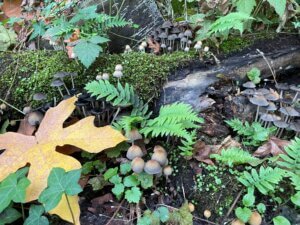
John Pyrch with fishing buddy near Ollalie Lake in 1962.
Editor’s Note: Long-time member and past Flyfisher Foundation President, John Pyrch, takes us back in time to his early days exploring Oregon waters to fish with a fly. LKH
My interest in fishing was sparked by the articles of outdoor writing icons Tom McAllister (Oregon Journal and Oregonian) and Ted Trueblood (Field & Stream). I grew up in West Linn when it was a series of small communities (Bolton, Sunset, Willamette) with a total population of about 3,000. My friends and I started fishing when were in grade school (1958-59) by riding our bikes to Sucker Creek (now called Lake Oswego Creek). There we caught bass, bluegill, and crappie using gear and bait. We also fished for carp in the various Willamette River side channels and pulled bass from between the logs stored in rafts along the banks of the river above the falls at Oregon City.
The famous Springer “hog line” across the Willamette just opposite the mouth of the Clackamas River was another fishing opportunity many of us enjoyed. In the Spring, angling for shad with light gear was a real treat. As we got older, we started hitting the Clackamas and its many tributaries. Initially we were dependent on our parents dropping us off at a designated campsite and picking us up several days later. After, when we were able to drive, we spent countless hours exploring and fishing the Clackamas drainage and its numerous tributaries and lakes – North Fork Reservoir, Roaring River, Fish Creek, Collawash River, Oak Grove Fork and lakes such as Harriet, Timothy, Trillium and Buck – whenever we could get away from our school and sport commitments. It was during this Clackamas phase of our fishing adventures that we learned to fly fish. I had a big white fiber glass Shakespeare Wonderod (8’ 6”) with a Pflueger 1495 CJ Medalist reel and a double tapered floating line. It was a very durable outfit that served me exceedingly well for several years.

One of our favorite destinations was Olallie Lake and the many lakes found in the surrounding area. In the early 1960’s, when we were in high school and didn’t drive yet, our parents took turns dropping us off at Olallie Lake and picking us up a week later. The long, rough road into Olallie was a real challenge (it still is). Back then you could camp anywhere since there were no designated campgrounds, just a primitive resort with cabins, a store, and a dock with boats you could rent. We would set up camp, fly fish around the shore of Olallie and explore the dozens of lakes that populated the area, including Monon, Breitenbush, Horseshoe, Long, Lower and Timber. Sometimes, if we had some spare change, we would rent a rowboat and work our way around Olallie Lake casting toward the shore for brookies and rainbows.
Fish Lake was our favorite. This 20-acre lake is located about two miles northwest of Olallie. There were no roads into the lake at that time just a steep trail that snaked through the forest of big trees that grew right up to the lake’s shore. There was a primitive log raft located on the south bank which we reinforced. We took turns rowing around the lake while casting to the sunken trees that lined the shore. The deal was to change rowing duties after landing a fish. It didn’t always work out that way (some guys didn’t want to stop fishing). The brookies came rushing from their cover to snatch our flies. Muddler Minnows and Coachman Bucktails were the most successful patterns. Casting to the logs and letting the fly sink before retrieving it in short jerks usually resulted in impressive takes by the hungry fish. The guy rowing would trail a fly off the back of the raft and often managed to hook and land rainbows or, occasionally, a cutthroat.
It was a great way to learn to fly fish and instill a love of the outdoors. Camping with no adult supervision. Swimming in the various lakes when it got too hot or when we needed a bath. We transformed huckleberries into a poor man’s pie; a layer of berries covered with white bread and then another layer of berries and more bread. It tasted great after a long day of hiking and fishing. One time in late July we hiked Olallie Butte and refreshed ourselves with snow that remained on the north slope of the volcano. Lifelong friendships resulted from these wonderful times and many of us still fish together when we get a chance.
John Pyrch


